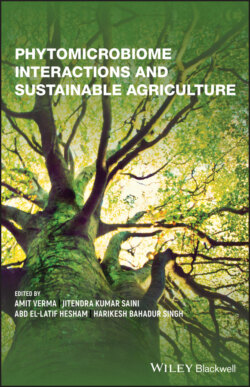Читать книгу Phytomicrobiome Interactions and Sustainable Agriculture - Группа авторов - Страница 28
2.6 Conclusion and Future Prospects
ОглавлениеThe significance of agriculture and sustained crop production to meet the growing need around the world cannot be understated. Specific emphasis in the field of crops is imperative given the rising trends of the population at the global level. Precision, reliability, and accuracy in pathogenic disease detection and diagnosis have become crucial to optimize crop health, yield, and quality. Myriad of biological organisms have been observed to play a positive as well as negative impact on plant health. The positive impact can be enhanced with the aid of technology to increase the overall plant growth. The negative impact can potentially have damaging consequences to crop production worldwide, thereby affecting the overall productivity. Therefore, we need techniques with high‐level advancement to assess the phytomicrobial association to derive benefit or precautionary measures well within time. Substantial changes take place within the cell during phytomicrobiome association leading to translation of a novel protein occurring due to plant and microbe genome interactions. Derivation of information on genomics and transcriptomics of plants microbe interactions is available, however, the need of the hour is to validate the data using proteomics. Several classic and recent techniques such as 2DE, MS, ICAT, DIGE, and MudPIT are at our disposal which are now proving to be effective and reliable enough to give us a validated result. The first instinct for the proteome analysis makes use of 2DE and MS for the preliminary extraction and separation of proteins of interest. Subsequently, the techniques are chosen to further delve deep into cellular functions. Owing to their reproducibility of results the data thus generated by such proteomic approaches are proving to be reliable. Identification of protein using peptide mass fingerprinting is filled with constraints owing to the need for the large‐scale sequence of the genome.
Table 2.2 Examples of phytomicrobiome interactions.
| Microorganism | Plant | Habitation | (+/−) Impact of Interaction | Type of Interaction |
|---|---|---|---|---|
| Bacillus amyloliquefaciens | Lolium perenne | rhizospheric | + | Indirect |
| Pseudomonas sp. | Helianthus tuberosus | endophytic | + | Indirect |
| Rhizophagus irregularis | Gossypium (17 sp.) | rhizospheric | + | Direct |
| M. lychnis‐dioicae | Silene latifolia | epiphytic | − | Direct |
| Fusarium proliferatum | Solanum lycopersicum | endophytic | − | Direct |
There is also a necessity to integrate the proteome generated data within the network of bioinformatics software to make the in‐silico analysis of proteomics more structured. This enhances the ability of the protein‐related data to get the validation through in silico analysis. Proteomics has leaped ahead to genomic and transcriptomic studies by making the analysis as close to reality as practically possible. Advancement in proteomics has led the research to leapfrog into the analysis which was simply hypothesized earlier, thereby acting as an aspect that cannot be dispensed of in the field of biological sciences, especially in plant microbial consortium.
